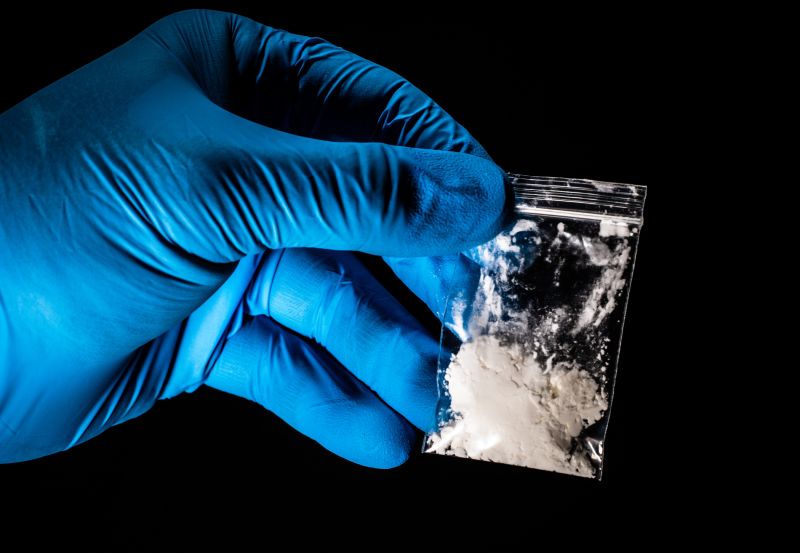The drug supply is constantly evolving, and some experts suggest that a “fourth wave” of the opioid epidemic is underway, in which illicit fentanyl is more frequently mixed with other drugs.
New research shows high levels of one unexpected addition: BTMPS, an industrial chemical used as an adhesive in the production of plastics, was found in the illicit fentanyl supply in the US.
“It’s probably one of the larger mysteries I’ve ever seen in my career,” said Morgan Godvin, project director at Drug Checking Los Angeles at UCLA and one of the authors of the research letter published last week in the medical journal JAMA.
BTMPS – an abbreviation for bis(2,2,6,6-tetramethyl-4-piperidyl) sebacate – protects plastics from UV light.
Research on the effects of BTMPS on humans are limited, but animal studies show health consequences such skin irritation, cardiotoxicity, reproductive defects, blurry vision and in some cases death. Experts also worry about lung damage since BTMPS can be inhaled.
For the study, researchers tested samples from nine community-based drug-checking programs across the country, including small samples of actual drug product that participants voluntarily brought to programs in Los Angeles and Philadelphia.
BTMPS was found in the fentanyl supply at all nine locations over four months, with more BTMPS than fentanyl in the product in most cases and an average percentage by mass of 8.6% BTMPS. Some samples were more than 56% BTMPS by mass.
“The fact that it’s there, it’s such a large amount, sometimes tells me that it’s being added … not just leeching in from the plastics they use to make the fentanyl,” said Dr. Chelsea Shover, lead author of the study and an assistant professor at the UCLA David Geffen School of Medicine and UCLA Fielding School of Public Health.
It’s still not clear exactly how BTMPS found its way into the fentanyl supply, but given the sudden emergence, Shover suggests that the chemical was introduced at the manufacturing level, either intentionally or accidentally.
The study also says the BTMPS could come from “a change in synthesis methods” or “added for dilution.”
The amount of BTMPS in the fentanyl supply alarmed Godvin, not just because “it’s toxic to almost every organ system” but also because of future effects.
“The average fentanyl user was exposed to large quantities of [BTMPS], and we don’t know what the long-term effects of this are,” Godvin said.
There are concerns that users who consumed fentanyl with a high percentage of BTMPS may have developed a lower fentanyl tolerance afterward, making them more susceptible to an overdose in the future.
“When we’re talking about fentanyl, where the margin of error for fatal overdose is so slim, these inconsistencies and volatilities can literally mean death,” Godvin said.
Fentanyl remains key driver of drug deaths
Illicit fentanyl has been a consistent driver of overdose deaths in the US. Synthetic opioids, a drug class that primarily comprises fentanyl, are involved in about two-thirds of the nation’s overdose deaths, according to data from the US Centers for Disease Control and Prevention.
A new report from Millennium Health, a laboratory that provides drug testing services, adds to growing evidence that the amount of fentanyl in the illicit drug supply is declining – 12% fewer samples were positive for fentanyl, compared with peak from 2022 – but 93% of fentanyl users had at least one other drug in their system, more than half of whom had three or more drugs present.
Sign up here to get The Results Are In with Dr. Sanjay Gupta every Friday from the CNN Health team.
The report’s findings also highlight a “flux” in the illicitly manufactured fentanyl supply in 2024, with varying amounts of fentanyl analogs depending on geographic location.
BTMPS was first identified in fentanyl by harm-reduction programs on the West Coast in June, prompting researchers to investigate the chemical more closely, according to the Street Drug Analysis Lab at the University of North Carolina at Chapel Hill.
Dr. Nabarun Dasgupta, a senior scientist at the University of North Carolina’s Injury Prevention Research Center, who runs the Street Drug Analysis Lab has found more than 850 drug samples with BTMPS in 14 states since April. He was not involved with the JAMA study, but his lab has extensively tracked opioid data over the past few years and it has found that the amount of BTMPS in the drug supply now seems to be declining.
“The biggest public health message is that an unregulated drug supply will always surprise you,” Dasgupta said.

